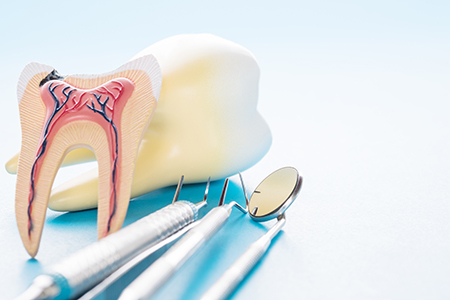
Being told you need a root canal can feel unsettling, but modern endodontic care is focused on relief, precision, and preserving your natural tooth whenever possible. Today’s root canal procedures are routinely performed with effective anesthesia and refined techniques that make them comparable in comfort to many common restorative appointments, such as a dental filling.
At Chilmark Dental P.C., our approach pairs up-to-date technology with patient-centered care so we can restore function, stop infection, and protect the long-term health of your smile. We prioritize clear communication and gentle treatment so you understand what to expect and feel confident in the care you receive.
Keeping a natural tooth whenever feasible has clear advantages for chewing efficiency, speech, and facial structure. When the inner tissues of a tooth are damaged by deep decay, trauma, or repeated dental work, a root canal can remove the source of infection while allowing the tooth’s outer structure to remain in place. This preserves your bite and helps prevent the bone loss that can follow extraction.
Root canal therapy is a focused, conservative option: instead of replacing the entire tooth, treatment targets only the diseased pulp and thoroughly cleans and seals the internal spaces. With proper restoration — often a crown or onlay — treated teeth can continue to function and look natural for many years.
Clinical success rates for root canal therapy are high when treatment is done promptly and the tooth is restored appropriately. Choosing to save a tooth through endodontic care can reduce the need for more invasive procedures later and supports overall oral health in a predictable way.

Inside every tooth is a small chamber that houses the dental pulp — soft tissue made up of nerves, blood vessels, and connective tissue. When decay reaches this inner chamber, or when a tooth sustains a significant crack or injury, bacteria can invade and cause inflammation or infection. Left untreated, that infection may spread to the root tip and surrounding bone.
Not every painful tooth requires root canal therapy, but certain conditions commonly indicate the need for endodontic treatment: deep cavities that reach the pulp, repeated restorative procedures on the same tooth, or a traumatic event that damages the pulp. Additionally, an infection may be discovered on an X-ray even before symptoms develop, underscoring the value of routine dental exams.
Because a mature tooth does not depend on the pulp to stay healthy, removing the infected or dead tissue and properly sealing the canals removes the source of pain and helps preserve the tooth’s form and function. Timely intervention reduces the chance of the problem spreading and simplifies eventual restoration.
Some symptoms clearly indicate that a tooth needs evaluation for possible root canal therapy. Persistent, severe toothache — especially pain that wakes you at night or lingers after exposure to hot or cold — often signals deep inflammation or infection. Likewise, a tooth that becomes sensitive to pressure or chewing may have internal pathology.
Other signs include visible darkening or discoloration of a single tooth after injury, localized swelling of the gums, and the development of a small pimple-like bump on the gum near a problematic tooth. In some cases a tooth may feel loose if the infection has affected the bone that supports it.
Pain that persists despite home care or recurs over days is a warning sign. Endodontic evaluation can determine whether the source is a compromised pulp or another dental condition.
Intense, lingering pain from hot or cold foods suggests that the nerve tissue inside the tooth is irritated or has been damaged.
Discomfort when biting down may indicate inflammation in the canals or a crack that transmits force to the inner tissues.
Changes in tooth color can reflect internal changes after trauma or necrosis of the pulp and should prompt evaluation.
Structural damage to a tooth can expose or injure the pulp, making endodontic treatment necessary to save the tooth.
Localized swelling or a draining tract on the gum often indicates an underlying infection that benefits from prompt treatment.
Mobility associated with pain or infection can sometimes be addressed through root canal therapy combined with appropriate restorative care.

Root canal treatment is performed to remove diseased pulp, disinfect the internal spaces, and seal the canals to prevent recontamination. Most procedures are completed under local anesthesia, and many patients report little to no discomfort during the appointment. When needed, additional comfort options such as sedation dentistry are available to help manage anxiety.
The number of visits varies based on the tooth’s anatomy and the presence of active infection. Some teeth can be treated in a single visit, while others benefit from staged care to ensure complete disinfection. Throughout the process, modern rotary instruments, magnification, and irrigation techniques improve precision and outcomes.
After the canals are cleaned and filled with a biocompatible material, the tooth is typically restored with a permanent filling and, in many cases, a crown to reinforce the remaining structure. Proper restoration is a key step in protecting the treated tooth from fracture and ensuring long-term function.

Following a root canal, it’s normal to have mild soreness or tenderness for a few days as surrounding tissues heal. Over-the-counter pain relievers are often sufficient; when stronger control is required, your dentist will provide guidance. Until the final restoration is placed, treated teeth may be more susceptible to fracture, so take care when chewing and avoid hard or sticky foods on that side.
Complete healing includes both relief from infection and the placement of a durable restoration. Timely follow-up to place a crown or definitive restoration protects the tooth’s integrity and helps prevent future problems. Maintaining consistent oral hygiene and regular dental check-ups supports the longevity of the treatment.
At Chilmark Dental P.C., our team emphasizes clear aftercare instructions and monitoring so each treated tooth has the best chance to remain healthy for years to come. If you experience prolonged or worsening symptoms after treatment, contact our office promptly for evaluation and care.
A root canal procedure is the best way to save a tooth that has been damaged by decay or injury and preserve your natural smile. The alternative is an extraction and treatment to replace the tooth. While at times a tooth is non-restorable and an extraction is the only option, when possible, it’s best to try and save your natural tooth. With proper care, a tooth with root canal therapy can serve your smile well for many years to come.
Despite lingering myths from before the age of modern dental anesthesia and technology, having a root canal procedure today is as routine and comfortable as visiting the dentist for a filling. While the procedure is performed under local anesthesia with your tooth completely numbed, we can also discuss options in dental sedation.
Whether the symptoms of a dental infection subside after a course of antibiotics, a draining abscess provides you with some temporary pain relief, or a tooth with radiographic evidence of pathology has not yet developed symptoms, it’s essential, before an infection worsens or occurs, to have a root canal procedure performed. In this way, the tooth can be disinfected, filled, and sealed to protect your health and avoid further problems.
If you have sustained a dental injury, have a toothache, jaw pain, swelling, or are experiencing any other unusual and uncomfortable oral symptoms, contact our office immediately for care. Dental problems that have not been evaluated and treated can significantly worsen, producing more severe damage and consequences for the involved teeth, your oral health, and even your overall wellbeing. Once you get in touch with our office, our friendly and compassionate office team will get you in for care at your earliest convenience.
While some root canal procedures can be completed in one visit, others may involve 2 or 3 appointments. How long it takes depends on various factors, including active infection, the number of canals in the tooth, and the tooth’s location or anatomy.
With a success rate that exceeds 95%, root canal therapy remains the most effective procedure to save a tooth in which the inner vital tissues have been damaged. However, as with all healthcare procedures, there are a small percentage of cases where the teeth become symptomatic a second time. The good news is that many of these teeth can still be saved with root canal retreatment or a minor surgical procedure known as an apicoectomy.
The best ways to maintain a tooth with root canal therapy are to get the proper restoration required to rebuild and protect the tooth, maintain proper oral hygiene, and schedule appointments for routine dental checkups and care.
Saving a tooth with root canal therapy is a wise investment that, in the long run, is typically less costly and invasive than having the tooth extracted and replaced with a fixed bridge or implant. As far as the exact cost of care, it can vary depending on which tooth is being treated. Many dental insurance plans provide coverage for root canal therapy. At the office of Chilmark Dental P.C., we do our best to optimize your dental benefits and minimize your out-of-pocket expenses. Our staff will answer all your questions about the cost of care and discuss all your payment options.
At the office of Chilmark Dental P.C., we use the latest technology and most effective methods of care to provide precise and gentle care. Our reputation for excellence is based upon a consistent record of achieving successful treatment outcomes while providing prompt, stress-free, and convenient treatment for every type of dental need.
A root canal is a dental procedure that removes infected or irreversibly damaged inner tissues of a tooth, known as the dental pulp, then cleans and seals the inside of the tooth to prevent reinfection. The goal is to preserve the natural tooth and restore its function while eliminating the source of pain or infection. Root canal therapy becomes necessary when decay, trauma, or deep restorative work has compromised the pulp so that it can no longer heal on its own.
When the pulp is inflamed or necrotic, leaving the tooth untreated can lead to persistent pain, spread of infection, or damage to surrounding bone. In many cases a root canal allows a tooth to be saved rather than extracted, which helps maintain chewing function and the alignment of surrounding teeth. Routine dental exams and radiographs often detect problems early, sometimes before obvious symptoms develop.
Tooth pain related to pulp inflammation or infection comes from irritated nerve tissue inside the tooth, and removing that tissue removes the pain source. During a root canal the dentist accesses the pulp chamber, removes diseased tissue, thoroughly cleans and disinfects the canals, and then fills the spaces to stop ongoing irritation and bacterial activity. This targeted treatment addresses the underlying cause rather than only masking symptoms with temporary measures.
After the canals are sealed and the tooth is restored, inflammation subsides and the surrounding tissues can heal, leading to lasting relief. Because the procedure eliminates the pathway for bacteria and inflammatory byproducts, it also reduces the risk of recurrent abscesses and further bone loss. Timely treatment improves the chances of a straightforward recovery and successful long-term function.
Common indicators include persistent or severe toothache that may wake you at night, prolonged sensitivity to hot or cold foods or drinks, and pain when biting or applying pressure. You may also notice swelling of the gums near the affected tooth, a pimple-like bump on the gum, darkening or discoloration of the tooth, or increased looseness of the tooth over time. These symptoms suggest pulp involvement but can overlap with other dental problems, so clinical evaluation is important.
It is also possible for a tooth needing treatment to produce few or no symptoms and to be discovered on a routine radiograph through signs of periapical pathology. For that reason, regular dental exams and x-rays are valuable for catching developing problems early. Prompt assessment prevents more extensive infection and can simplify treatment.
At the office of Chilmark Dental P.C., root canal treatment begins with a thorough evaluation, local anesthesia to ensure comfort, and isolation of the tooth with a rubber dam to keep the area dry. The dentist then creates a small access opening into the crown, removes the diseased pulp, and shapes the canals using specialized instruments and irrigation to eliminate bacteria. Once clean, each canal is filled with a biocompatible material to seal the internal space and prevent reinfection.
After the root canal itself, the tooth is temporarily restored and later rebuilt with a permanent crown or restoration to restore strength and function. Some cases are completed in a single visit while others require multiple appointments depending on complexity and infection status. Sedation options are available for patients who experience anxiety, and the team will explain follow-up steps to ensure a durable outcome.
Modern root canal therapy is generally no more uncomfortable than receiving a routine filling because local anesthesia effectively numbs the area during treatment. Many patients report significant relief from the severe pain they experienced prior to treatment once the procedure addresses the infected or inflamed pulp. The dental team uses gentle techniques and can offer sedation when needed to enhance comfort for anxious patients.
After the procedure, it is normal to experience mild to moderate soreness or tenderness for a few days as surrounding tissues recover, and over-the-counter pain relievers usually control this discomfort. If pain increases, persists beyond a few days, or is accompanied by fever or swelling, you should contact the practice promptly for evaluation. Most post-treatment symptoms subside quickly and respond well to simple self-care and prescribed medications when required.
Immediately after treatment avoid chewing on the treated tooth until the final restoration is placed, and follow any instructions about antibiotics or pain medication if they are prescribed. Protect the area while the temporary filling is in place by avoiding hard, sticky, or chewy foods that could dislodge the restoration. Maintain careful oral hygiene by brushing and flossing gently around the treated tooth to support healing.
It is important to return for the recommended permanent restoration, such as a crown, to restore tooth strength and prevent fracture or reinfection. Continue routine dental checkups and professional cleanings so your dentist can monitor healing and the integrity of the restoration. With proper care and timely restoration, a root canal–treated tooth can remain functional for many years.
The duration and number of visits needed depend on factors such as the tooth’s anatomy, the number of canals, and whether an active infection is present. Simple front-tooth root canals can often be completed in one visit lasting about 45 to 60 minutes, while multi-rooted molars commonly require 60 to 90 minutes and sometimes multiple appointments. If an infection needs to be controlled before final cleaning and sealing, the dentist may place medication inside the canals and schedule follow-up visits.
Your dentist will explain the expected treatment timeline during the consultation and provide clear instructions for each appointment. Efficient techniques and modern instruments often reduce chair time while maintaining high standards of care. After the root canal itself, you should plan for an additional visit to have a permanent crown or restoration placed to protect the tooth.
Yes, with appropriate restoration and ongoing oral hygiene a tooth that has received root canal treatment can function successfully for many years and often for a lifetime. The internal infection is eliminated during the root canal and the canals are sealed, but the remaining tooth structure is susceptible to fracture without a protective restoration such as a crown. Rebuilding the tooth's form and strength helps restore normal chewing function and prevents future problems.
Regular dental examinations and prompt treatment of new decay are important to maintain the restored tooth and surrounding tissues. In a minority of cases a previously treated tooth may require retreatment or surgical intervention if persistent or recurrent infection develops. Early detection and timely management improve the odds of long-term success.
You should seek urgent dental attention if you experience severe, uncontrolled tooth pain, significant swelling of the face or gums, difficulty breathing or swallowing, or a high fever accompanying a dental problem. These signs can indicate a spreading infection that requires prompt evaluation and immediate care to reduce the risk of serious complications. Even if symptoms are less dramatic but persistent or worsening, contact your dental office so the situation can be assessed.
In an emergency the dentist may provide pain relief, prescribe antibiotics when appropriate, or perform a temporary procedure to drain an abscess or stabilize the tooth until definitive root canal therapy can be completed. Quick action reduces the chance of more extensive treatment and helps protect your overall health. If you are unable to reach your regular dentist, seek care at an emergency dental clinic or hospital for evaluation.
Chilmark Dental P.C. combines experienced clinicians, modern technology, and a focus on patient comfort to provide conservative, evidence-based root canal care in Ossining, NY. The practice emphasizes clear communication, individualized treatment planning, and options such as local anesthesia and sedation to accommodate patient comfort and clinical needs. Using up-to-date instruments and techniques supports efficient cleaning, disinfection, and reliable sealing of treated canals.
Our team coordinates follow-up care, including restoration with crowns or other protective restorations, and works with patients to schedule timely appointments for optimal outcomes. We accept most PPO insurance plans and welcome new patients who need prompt attention for painful or infected teeth. If you have questions about treatment or need an evaluation, the office staff can help you arrange an appointment and explain what to expect.
Phone:
Email: